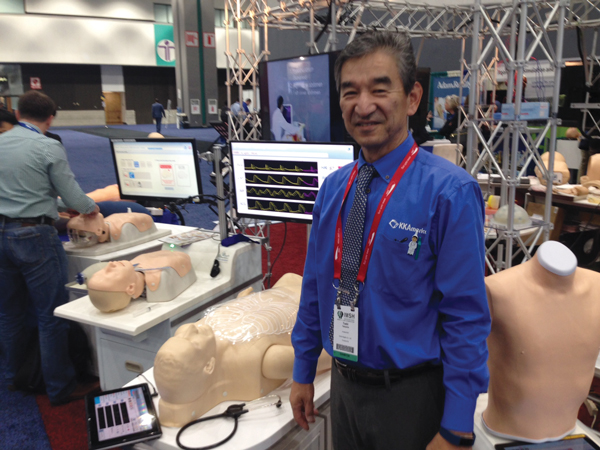The Los Angeles Convention Center was packed last week with mannequins meant to simulate medical patients, from mother models who birthed babies to combat veteran stand-ins that displayed gory war wounds.
Each mannequin at the January 13-17 run of the International Meeting for Simulation in Healthcare – put on by the Society for Simulation in Healthcare – was backed by a medical simulation company hoping to sell the dummies in the fast-growing market segment.
The market for lifelike mannequins, virtual reality surgery aids and anatomical software packages – all technologies increasingly used to help train doctors, nurses and other medical professionals – is projected to double to $3.1 billion in 2021 from $1.6 billion in 2016, according to market research firm Mordor Intelligence.
That means big business for some local companies.
“We just launched a complete OB-GYN curriculum, we’re positioned for growth,” said Heidi Wienckowski, vice president for business development for SonoSim Inc., of Santa Monica, a medical education software firm that sells mannequins and software packages to teach ultrasonography.
The IMSH 2018 show drew a record 267 exhibitors, including 100 live vendors from 16 countries and 22 states, officials said. Nearly half a dozen companies and institutions from Los Angeles County displayed products to an estimated 3,000 visitors.
Robo Doc?
The convention floor was filled with computerized mannequins, from baby boys whose stomachs rose and fell with each simulated breath to battlefield casualties replete with realistic burn, shrapnel and gunshot wounds, or limbs lost to roadside mine blasts.
The figures are meant to serve as training subjects for future surgeons, but also can double as vehicles for more experienced medical professionals learning new or updated procedures.
The convention also featured companies hawking virtual reality programs and other software designed to educate medical professionals.
Companies pitched their products as tools to help make real patient procedures a little less painful, a little more comforting and a lot safer.
“It can turn the stomach, but the ultimate good is better patient care,” said Dr. Joseph Lopreiato, incoming president for the Society for Simulation in Healthcare and a practicing pediatrician. “This is batting practice before the big game. We’re running out of room. Going gang-busters. It’s a real growth industry.”
The medical simulation industry now employs a wide range of technology to lend a feel for faux patients from the ambulance to the operating table.
Role-playing actors are made up to simulate victims. Mannequins are created to simulate body parts. Virtual reality software now simulates minute surgeries, and augmented reality allows users to see a patient’s internal organs with a swipe of a smartphone.
A study by MarketsandMarkets Inc. concluded the global market for medical simulation products would grow from $1.1 billion in 2016 to $2.6 billion in 2022, largely driven by an increasing demand for minimally invasive medical treatments and an increasing focus on patient safety.
Show and Tell
Kyoto Kagaku Co. Inc., a medical skills training firm based in Japan with a U.S. subsidiary based in Torrance, sells a wide range of rubbery body appendages, including a $2,000 lumbar puncture simulator with a life-like skin that resists a surgeon’s spinal needle. The company’s display table at the convention center featured rows of body parts with see-through windows into rib cages, mammary glands and other body parts.
Toshi Takayama, chief executive of Kyoto Kagaku America, said the L.A. show is an important marketing and sales platform for the company.
“The U.S. has numerous medical schools and simulation centers,” he said. “It’s a good market, with a lot of competition. In 2005, I remember only a dozen vendors (here), but there are now nearly 100.”
SonoSim’s Wienchowski also said the confab was an important business development opportunity for the eight-year old company, which was founded by Dr. Eric Savitsky, also founder of the UCLA Center for International Medicine.
“It’s actually our most popular show, and the most important,” said Wienckowski, who declined to reveal company revenues. “A huge market for us is simulation centers – and their reps are here.”
Staff Reporter Dana Bartholomew can be reached at [email protected] or (323) 556-8333.

